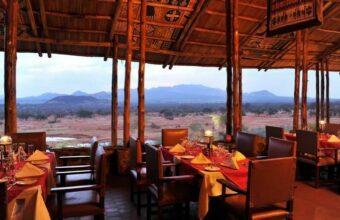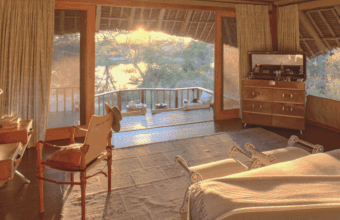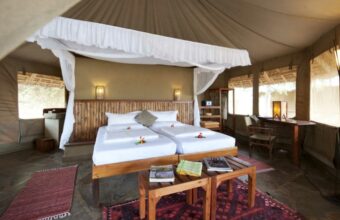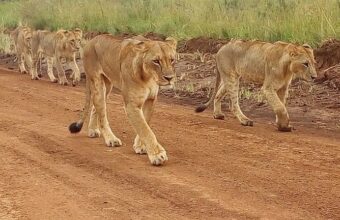Safaris in Tsavo East & West National Parks
Combined, Tsavo East and West National Parks cover an enormous swathe of Kenya. Tsavo West alone (the bigger of the two parks) covers an area greater in size than Wales, or two and half times the size of Yellowstone National Park.
The two parks are separated from each other by the Nairobi-Mombasa highway and are easy to reach from either city.
Despite being directly adjacent, the two parks are radically different from one another with the green hills of Tsavo East a marked contrast to the red soil and volcanic landscapes of Tsavo West.
While the generally arid climate can't support the diversity of life of the Mara, Tsavo is still home to all the big five, including many prides of the Tsavo lion, whose males are known for their lack of manes and heightened aggression – in 1898, two maneless Tsavo lions, known as the Maneaters of Tsavo, killed more than 130 people.
Tsavo is home to many other Kenya safari staples such as hippos, impalas, dik-dik and hundreds of bird species. But this is primarily elephant country and Tsavo is renowned for the size of its tuskers (or rather, was renowned for them: sadly poachers have killed many of the more impressively tusked elephants).
Given the size of the parks, the game populations are much less compact and therefore harder to spot. But there is a more peaceful atmosphere to the Tsavo safari experience. Lodges in Tsavo generally offer transfers to and from the train stations at Voi and Mtito Andei as well as from the several airstrips in the parks.

Giraffe standing tall in Tsavo East National Park
Best safari camps & lodges in Tsavo
Our expert's top picks
-
Tsavo East & West National Parks
View trips -
Tsavo East & West National Parks
View trips -
Tsavo East & West National Parks
View trips -
Tsavo East & West National Parks
View trips
Best time to visit the Tsavo National Parks
Any time between June and February is great for Tsavo (though it gets very hot by late February). The middle of the dry seasons (Sept-Oct and Jan-early March) sees wildlife congregating around water sources and consequently these are the best periods to be here. Park tracks can be washed away and many camps close during heavy March-June rains.
Tsavo National Parks wildlife
Tsavo has a diverse collection of wildlife, including some dry country species that you won’t see in the Masai Mara. However, because of the drier nature of the terrain and lower population density you’ll need to be patient.
Key species include elephants – some of which have reached huge sizes and many of which spend half their life coated in Tsavo’s fine red dust.
The parks are also renowned for their lions, and both leopard and cheetah are seen with some regularity.
If you’re really lucky you might see wild dogs or several cat species.Rhinos are present in the special rhino sanctuary but are also occasionally seen living elsewhere in the park.
Of the grazers, zebra and wildebeest are common and there are some unusual dry country species such as the gerenuk and oryx.
The birdlife is superb with some 500 species recorded.
Tsavo highlights
Aquatic life
At Mzima Springs, a beautiful green oasis with sky blue waters, the park authorities have constructed an underwater viewing chamber which allows you to peek in on hundreds of fish and – if you’re really lucky – one of the resident crocs or hippos.
Lava flows
The Shetani lava flows, just outside of Tsavo West, are a 50sqkm slab of petrified lava flow laid down just a few hundred years ago. This alien landscape offers startling views and you can hike up to the cinder cone.
Rhino spotting
A reserve within a reserve, the Ngulia Rhino Sanctuary protects what remains of Tsavo’s once huge rhino population and a visit is a sure fire way of getting to see some of Kenya’s black rhino.
Kanderi swamp
One of the most idyllic places within this dusty, scrubby landscape, the Kanderi Swamp offers year round permanent water and grazing and as such attracts an impressive number of animals including plenty of lion and elephant.
How to get to Tsavo National Parks
Tsavo is easy to fit into an overland journey along the Nairobi-Mombasa highway as the main gates lie right off this road. This makes Tsavo a good choice for independent travellers. As with the Masai Mara though most people fly with Air Kenya (www.airkenya.com) and Safari Link (www.flysafarilink.com) from Nairobi, the coast or Amboseli and Masai Mara parks.
Tsavo safaris FAQs
Question
I'm visiting Tsavo in April. Finch Hattons looks amazing but mega bucks, can you suggest the next best thing? Looking for an authentic stay with a touch of luxury.
Answer
As you have discovered the real top end safari accommodation in Kenya are eye-wateringly expensive. Kilaguni Serena Safari is a more accessibly-priced nice lodge not far from Finch Hattons. It's still far from a budget offering and it's much larger than Finch Hattons but the Serena offerings are generally pretty good value.


















